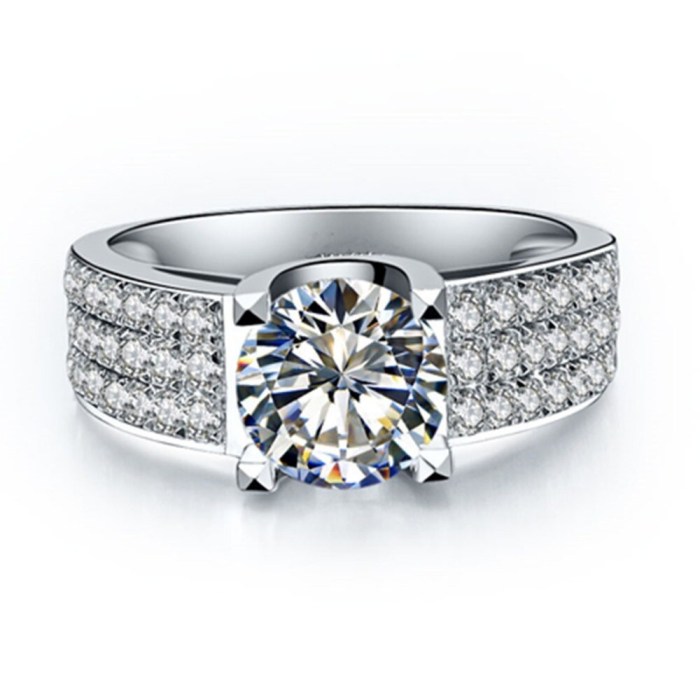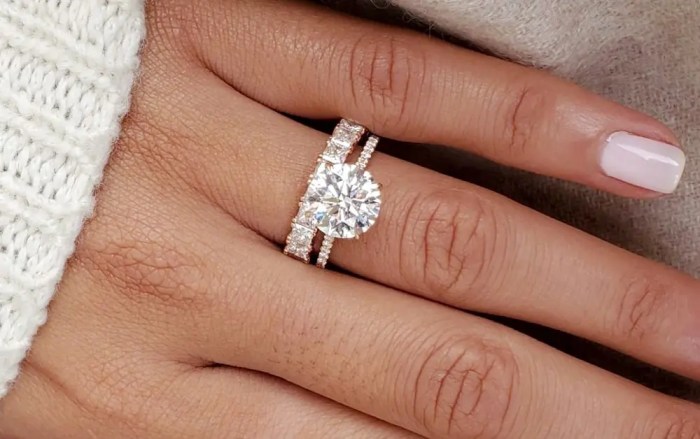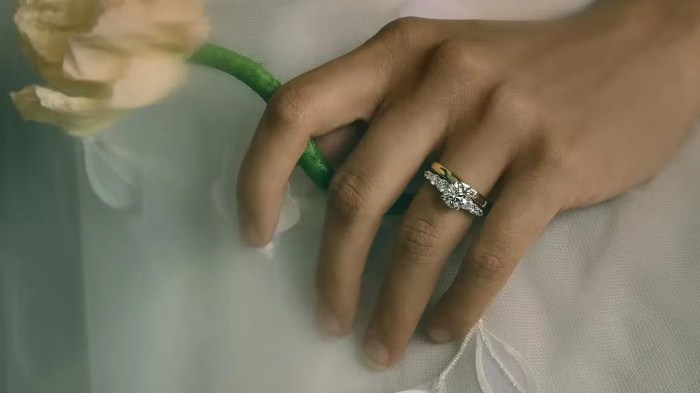Engagement rings with lab grown diamonds are making waves in the jewelry world, offering a modern twist on a timeless classic. These diamonds, created in controlled environments, share the same physical and chemical properties as their mined counterparts but come with a host of benefits that appeal to today’s conscious consumers. Not only do they represent a commitment to love, but they also reflect an ethical choice that is kinder to the planet.
With their unique features, including environmental sustainability and ethical sourcing, lab grown diamonds are revolutionizing the engagement ring market. As trends shift and more couples seek alternatives, exploring the various styles and settings available, along with understanding the financial implications, becomes essential for making informed decisions.
Features of Lab Grown Diamonds in Engagement Rings

Source: therectangular.com
Lab grown diamonds have emerged as a compelling alternative to natural diamonds, especially in the context of engagement rings. These exquisite gemstones not only mimic the beauty and sparkle of their mined counterparts but also come with a range of benefits that appeal to today’s conscious consumers. Understanding the unique characteristics of lab grown diamonds is essential for anyone considering an engagement ring that combines elegance with ethical choices.Lab grown diamonds are created using advanced technological processes that replicate the conditions under which natural diamonds form.
As a result, they share the same physical, chemical, and optical properties as diamonds mined from the earth. The most significant differentiator lies in their origin; lab grown diamonds are produced in a controlled environment, allowing for precise crafting and consistent quality. This process not only ensures that they are virtually indistinguishable from natural diamonds but also offers several benefits that reflect modern values.
Environmental and Ethical Benefits
The environmental and ethical considerations surrounding the diamond industry have become increasingly significant to consumers. Lab grown diamonds present a responsible choice, as they require substantially fewer resources and pose minimal environmental impact compared to traditional diamond mining. The following points Artikel the key benefits of selecting lab grown diamonds:
- Reduced Carbon Footprint: The creation of lab grown diamonds results in a significantly lower carbon footprint than mining, which can contribute to deforestation and habitat destruction.
- Water Conservation: Lab grown diamond production uses significantly less water than diamond mining, which often leads to depletion of local water resources.
- Conflict-Free Assurance: Lab grown diamonds are conflict-free, meaning they are not sourced from regions where mining operations fund violence or human rights abuses.
- Transparency: Purchasing lab grown diamonds often provides better traceability regarding ethical sourcing and production practices.
Grading Standards for Lab Grown Diamonds
When it comes to grading, lab grown diamonds adhere to the same standards used for natural diamonds, ensuring that consumers can make informed decisions based on quality. The grading of diamonds is typically based on the “Four Cs”: Carat, Cut, Color, and Clarity. These grading criteria apply equally to lab grown diamonds, making it easier for buyers to compare. The grading process involves rigorous examination by certified gemologists using advanced equipment.
Noteworthy grading reports from reputable laboratories like the Gemological Institute of America (GIA) and the International Gemological Institute (IGI) provide assurance of quality. The following are key aspects of grading lab grown diamonds:
- Carat: This measures the weight of the diamond, which directly influences its size. Lab grown diamonds can be produced in larger carat weights at lower prices than mined diamonds.
- Cut: The quality of the cut affects how well the diamond reflects light, impacting its overall beauty. Lab grown diamonds are often crafted using advanced technology to achieve superior cuts.
- Color: Lab grown diamonds can be produced in various colors, and their grading matches the same scale as natural diamonds. Colorless lab grown diamonds are among the most sought after.
- Clarity: This refers to the presence of internal or external flaws. Lab grown diamonds can often exhibit higher clarity grades compared to their natural counterparts, resulting in visually stunning pieces.
“Lab grown diamonds provide an innovative choice that aligns beauty with ethical considerations, offering a brilliant alternative to traditional engagement rings.”
Popular Styles and Settings for Engagement Rings

Source: vogue.com
Engagement rings featuring lab-grown diamonds are making waves in the jewelry world, offering both ethical and aesthetic appeal. As couples increasingly embrace these innovative alternatives to natural diamonds, the styles and settings have evolved to reflect modern tastes while still honoring traditional designs. From minimalist elegance to ornate details, there’s a perfect ring style for every love story.Current trends in engagement ring styles highlight the versatility of lab-grown diamonds, allowing for customization and creativity in design.
One of the key attractions of these diamonds is that they can be set in various styles that cater to both classic and contemporary preferences. Couples are increasingly opting for unique shapes and settings that speak to their individuality and values.
If you’re in the market for something truly special, consider the option to buy lab grown diamond ring. These rings not only offer the same brilliance and beauty as natural diamonds but are also more environmentally friendly. With a variety of styles available, you can find the perfect piece that matches your tastes and values without compromising quality.
Popular Settings for Lab Grown Diamonds, Engagement rings with lab grown diamonds
When selecting an engagement ring, the setting plays a vital role in showcasing the beauty of the diamond. Here are some of the most popular settings that complement lab-grown diamonds beautifully:
- Solitaire: A timeless classic, the solitaire setting features a single lab-grown diamond, emphasizing its brilliance and simplicity.
- Halo: This design encircles the central diamond with a ring of smaller diamonds, enhancing its sparkle and creating a stunning visual impact.
- Three-Stone: Symbolizing the past, present, and future, this setting includes a central diamond flanked by two smaller ones, offering a meaningful and elegant look.
- Pavé: With tiny diamonds set closely together along the band, this setting adds extra brilliance and texture, making it perfect for those who love a bit of glam.
- Vintage: Inspired by historical designs, vintage settings often feature intricate details and filigree work, providing a romantic and nostalgic feel.
- Twisted Band: This modern interpretation features a band that twists around itself, creating a unique and eye-catching design that showcases the diamond in a fresh way.
Comparison of Traditional vs. Modern Designs
The engagement ring landscape is rich with both traditional and modern designs, each offering distinct characteristics that can complement lab-grown diamonds. Traditional designs often include classic settings and shapes, focusing on timeless elegance, whereas modern designs tend to push boundaries with innovative styles and artistic influences.
| Aspect | Traditional Designs | Modern Designs |
|---|---|---|
| Design Approach | Classic and timeless | Bold and innovative |
| Setting Style | Solitaire and halo styles | Unique settings like twisted bands or asymmetrical designs |
| Diamond Shape | Round or princess cuts | Emerald, oval, and other fancy cuts |
| Overall Aesthetic | Elegant and understated | Contemporary and eye-catching |
“Lab-grown diamonds seamlessly blend into both traditional and modern designs, offering a sustainable choice without compromising on style.”
As you explore engagement ring options, consider how both traditional and modern elements can be combined to create a truly unique piece that reflects your personal story and values.
Cost Considerations and Value of Lab Grown Diamonds

Source: diamondexchangehouston.com
When it comes to choosing an engagement ring, understanding the cost considerations associated with lab grown diamonds versus natural diamonds can significantly influence your purchasing decision. Lab grown diamonds offer a more affordable alternative, allowing for more flexibility in budgeting while still achieving the desired quality and sparkle.The price difference between lab grown and natural diamonds is quite substantial. On average, lab grown diamonds cost 20% to 40% less than their natural counterparts.
This cost reduction is primarily due to the controlled environment in which lab grown diamonds are created, eliminating the mining costs and the long supply chain typically associated with natural diamonds. For example, a one-carat lab grown diamond might retail for around $2,500, while a similar natural diamond could easily exceed $4,000 or more, depending on the quality and rarity.
If you’re considering a unique and sustainable option for an engagement ring, you might want to buy lab grown diamond ring. These diamonds are created in a controlled environment and offer the same brilliance as natural diamonds, but at a more affordable price. Plus, choosing a lab-grown diamond is an eco-friendly decision that appeals to many modern couples.
Budgeting for an Engagement Ring
Choosing a lab grown diamond can greatly influence your overall budget for an engagement ring. This flexibility allows couples to allocate their funds more thoughtfully, potentially opting for a larger stone or a more intricate setting without financial strain. The budgetary benefits of lab grown diamonds can be summarized in several key points:
- Affordability: Budget-conscious couples can enjoy a high-quality diamond without sacrificing aesthetics or size.
- Higher Quality Options: With the same budget, buyers can afford diamonds with superior cut, color, and clarity.
- Potential for Additional Features: Couples can invest in unique settings or additional gemstones, enhancing the overall ring design.
Choosing a lab grown diamond opens up possibilities that might have been financially out of reach with natural diamonds, allowing for personalized ring designs tailored to individual preferences.
Resale Value of Lab Grown Diamonds
The resale value of lab grown diamonds tends to be lower compared to natural diamonds, primarily due to market perceptions and demand dynamics. While natural diamonds have an established resale market, lab grown diamonds, being relatively new, lack the same level of market recognition. Factors influencing resale value include:
- Market Demand: As awareness and acceptance of lab grown diamonds grow, so may their resale potential.
- Condition and Quality: The overall condition and quality of the diamond will play a significant role in its resale value.
- Branding and Certification: Diamonds that come with reputable certifications or are from recognized brands may retain a higher resale value.
In summary, while lab grown diamonds are generally more affordable and allow for creative ring design, their resale value is typically less than that of natural diamonds. This is an essential consideration for buyers thinking about long-term value and investment when selecting their engagement ring.
Buying Guide for Engagement Rings with Lab Grown Diamonds

Source: vogue.com
When it comes to selecting the perfect engagement ring with a lab grown diamond, the process can be both exciting and overwhelming. Understanding the key aspects and features of lab grown diamonds helps ensure that you make a choice that reflects your values and style. This guide will provide essential tips on selecting an engagement ring that suits your beloved and offers guidance on evaluating the most reputable sellers in the market.The significance of certification cannot be overstated when purchasing lab grown diamonds.
Certifications from recognized gemological laboratories like the Gemological Institute of America (GIA) or the International Gemological Institute (IGI) serve as proof of the diamond’s quality, including its cut, color, clarity, and carat weight. Being informed on how to spot credible sellers will protect you from fraudulent practices and ensure that you’re investing in a genuine product.
Important Tips for Selecting the Perfect Engagement Ring
Finding the right engagement ring involves considering several factors that contribute to its overall appeal and value. Here are some essential tips that can help in making the decision easier:
- Set a Budget: Before you start shopping, decide on how much you are willing to spend. Lab grown diamonds typically cost 20-40% less than their mined counterparts, allowing for more flexibility in your budget.
- Understand the 4 Cs: Familiarize yourself with the cut, color, clarity, and carat weight of diamonds. Each ‘C’ affects the diamond’s appearance and value significantly.
- Choose the Right Metal: Consider the band material, such as platinum, white gold, yellow gold, or rose gold. Each metal has its own characteristics and appearance that can greatly alter the look of the ring.
- Consider Style Preferences: Engage in discussions with your partner or observe their jewelry preferences to identify styles they might love, such as solitaire, halo, or vintage designs.
- Seek Certification: Always ask for certification from reputable labs to ensure the diamond’s quality and authenticity.
Identifying Reputable Sellers of Lab Grown Diamonds
To ensure a positive purchase experience, knowing how to identify trustworthy sellers is crucial. Certified dealers offer assurance regarding the quality and ethical sourcing of lab grown diamonds. Look for the following attributes when choosing a retailer:
- Certifications: Verify that the seller provides diamonds certified by recognized gemological laboratories.
- Customer Reviews: Research online reviews and testimonials from previous customers. This can provide insight into the seller’s reliability and customer service.
- Return Policies: Reputable sellers typically have clear and fair return policies, allowing for exchanges or returns if necessary.
- Transparency: A trustworthy seller will provide detailed information about the diamond, including its origin and the process it underwent to be lab grown.
- Physical Store Availability: If possible, choose a retailer with a physical location where you can view the diamond and discuss options in person.
Checklist for Purchasing an Engagement Ring with a Lab Grown Diamond
Having a checklist can streamline the engagement ring buying process. Here’s a handy list of considerations to keep in mind:
- Have a clear budget established.
- Identify your partner’s style and preferences.
- Research the 4 Cs of diamonds thoroughly.
- Choose a metal that complements the diamond.
- Ensure the diamond comes with a certification from a recognized lab.
- Research the seller’s reputation through customer reviews.
- Understand return and exchange policies.
- Make time for consultations or visits to retailers.
Purchasing an engagement ring is a significant decision, and being well-informed helps ensure you choose a piece that represents both love and commitment beautifully.
Last Point: Engagement Rings With Lab Grown Diamonds

Source: allurez.com
In conclusion, choosing engagement rings with lab grown diamonds opens up a world of possibilities that blend beauty and responsibility. As couples look for rings that symbolize their unique love stories, lab grown diamonds offer an attractive option that aligns with modern values. With a variety of styles, settings, and affordability, these rings not only celebrate love but also reflect a commitment to a sustainable future.
Questions and Answers
What are lab grown diamonds?
Lab grown diamonds are diamonds that are created in a laboratory setting using advanced technology, replicating the natural processes that form diamonds in the earth.
Are lab grown diamonds less valuable than mined diamonds?
Typically, lab grown diamonds are less expensive than mined diamonds due to lower production costs, but their value can vary based on quality and market demand.
Do lab grown diamonds come with certification?
Yes, most lab grown diamonds come with certification from recognized gemological laboratories, ensuring their quality and specifications.
How do I choose the right lab grown diamond for my engagement ring?
Consider factors such as the 4 Cs (cut, color, clarity, carat weight), your budget, and the ring style that best represents your partner’s taste.
Can lab grown diamonds be resold?
Yes, lab grown diamonds can be resold, but their resale value tends to be lower than that of mined diamonds due to current market trends.